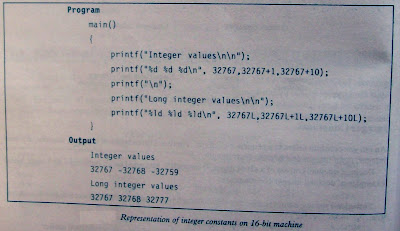Data Types :
C language is rich in its data types. Storage representations and machine instructions to handle constants differ from machine to machine. The variety of data types available allow the programmer to select the type appropriate to the needs of the application as well as the machine.
C supports three classes of data types:
1. Primary (or fundamental) data types
2. Derived data types
3. User-defined data types
The primary data types and their extensions are discussed in this section. The user-defined data types are defined in the next section while the derived data types such as arrays, functions, structures and pointers are discussed as and when they are encountered.
All C compilers support five fundamental data types, namely integer (int), character (char), floating point (float), double-precision floating point (double) and void. Many of them also offer extended data types such as long int and long double. Various data types and the terminology used to describe them are given in Fig. . The range of the basic four types are given in Table . We discuss briefly each one of them in this section.
Integer Types
Integers are whole numbers with a range of values supported by a particular machine. Generally, integers occupy one word of storage, and since the word sizes of machines vary (typically, 16 or 32 bits) the size of an integer that can be stored depends on the computer. If we use a 16 bit word length, the size of the integer value is limited to the range —32768 to -1-32767 (that is, —215 to +
215 - 1). A signed integer uses one bit for sign and 15 bits for the magnitude of the number. Similarly, a 32 bit word length can store an integer ranging from -2,147,483,648 to 2,147,483,647.
In order to provide some control over the range of numbers and storage space. C has three classes of integer storage, namely short int, int, and long int, in both signed and unsigned forms. C defines these types so that they can be organized from the smallest to the largest, as shown in Fig. . For example, short int represents fairly small integer values and requires half the amount of storage as a regular int number uses. Unlike signed integers, unsigned integers use all the bits for the magnitude of the number and are always positive. Therefore, for a 16 bit machine, the range of unsigned integer numbers will be from 0 to 65,535.
We declare long and unsigned integers to increase the range of values. The use of qualifier signed on integers is optional because the default declaration assumes a signed number. Table shows all the allowed combinations of basic types and qualifiers and their size and range on a 16-bit machine.
Floating Point Types
Floating point (or real) numbers are stored in 32 bits (on all 16 bit and 32 bit machines), with 6 digits of precision. Floating point numbers are defined in C by the keyword float. When the accuracy provided by a float number is not sufficient, the type double can be used to define the number. A double data type number uses 64 bits giving a precision of 14 digits. These are known as douhle precision numbers. Remember that double type represents the same data type that float represents, but with a greater precision. To extend the precision further, we may use long double which uses 80 bits. The relationship among floating types is illustrated in Fig. .
Viod Types
The void type has no values. This is usually used to specify the type of function. The type of a function is said to be void when it dose not return any value to the calling function. It can also play the role of a generic type, meaning that it can represent any of the other standard types .
Character Types
A single character can be defined as a character (char) type data. Character are usually stored in 8 bits (one byte) of internal storage. The qualifier signed or unsigned may be explicitly applied to char. While unsigned chars have value between 0 and 255. signed chars have values from - 128 to 127









